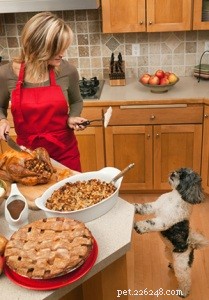Par Sarah-Anne Reed, dresseuse de chiens holistique et propriétaire de Pack Dynamics, LLC ®
Parfois, nous encourageons notre chien à mendier sans nous en rendre compte. Voici comment :
• Leur donnez-vous la nourriture de votre assiette après avoir fini de dîner ?
• Les laissez-vous lécher votre bol après avoir mangé de la crème glacée ?
• Leur donnez-vous une partie de votre nourriture comme vous préparez des repas dans la cuisine ?
• Est-ce que votre enfant lui faufile de la nourriture pendant qu'il mange ?
• La nourriture tombe parfois par terre depuis la chaise haute ?
• Pensez-vous c'est mignon quand ton chien aspire tout ce qui tombe par terre ?
Ce sont des erreurs courantes que les gens commettent et contribuent aux comportements de mendicité de leur chien pendant qu'ils mangent ou qu'ils planent à table lorsqu'ils reçoivent des invités.
Techniques pour empêcher votre chien de mendier
1. Gardez les aliments dans le bol :Il est essentiel de toujours donner à votre chien ses repas dans sa gamelle. Vous pouvez leur donner de la "nourriture humaine", mais il est important de l'inclure soit dans l'un de leurs repas réguliers, soit comme collation, mais toujours dans leur bol de nourriture et jamais immédiatement après avoir mangé. Sinon, votre chien commencera à s'attendre à ce que vous partagiez vos repas avec lui. Vous pouvez également conserver la nourriture pour plus tard et la leur donner pour donner suite à une demande, comme "s'asseoir", pendant que vous vous entraînez.

2. Faites de la cuisine une zone interdite pendant la préparation des repas : Si votre chien est sous les pieds dans la cuisine, bloquez l'accès à la cuisine avec une barrière pour bébé pour l'empêcher de chercher de la nourriture et de trébucher dessus avec une poêle chaude. Se tiennent-ils près de la chaise haute, la bouche ouverte, pendant que votre bébé mange, espérant simplement que quelque chose tombera du ciel ? Mettez votre chien dans une autre pièce, dans sa caisse ou derrière une barrière pour bébé pendant que votre bébé mange. Nettoyez tout ce qui a pu tomber sur le sol après chaque repas, avant de laisser votre chien vous rejoindre.
3. Ignorez le gémissement : If your dog starts barking, whining, or pawing for food, completely ignore them. Don’t look at them, talk to them, or respond at all.
4. Consistency is key: After a while, your dog will realize that their old tactics of trying to get food don’t work, and they will stop begging. The key is to be patient and consistent. They may add to their repertoire of trying to tell you that they want some of your food. Don’t worry, this means that your dog is smart and getting creative to get your attention. Just stay strong and don’t give in. You won’t hurt their feelings; you are just letting them know that they can’t demand food from you. You would never give a child another cookie if they had a tantrum because they didn’t get their way. It’s vital that we have clear boundaries with our dogs and not give in to their demands as they beg for food.
Human foods dogs can enjoy (in their bowl)
Most dogs enjoy variety in their food, just like we do. You can add some roasted sweet potatoes or carrots to their food as a special treat. Raw broccoli is a great option too. Some dogs like sweeter treats, like bananas or blueberries.
Dogs like different textures; some dogs prefer crunchy, others would prefer something steamed or roasted. Just like us, every dog is unique. Make sure that you don’t give them anything seasoned, as it could be harmful. Here is a complete list of human foods and whether they are safe for dogs.
About the author
Sarah-Anne Reed has a unique set of skills, experience, and education that allow her to offer an innovative, dynamic approach to solving canine behavioral issues.
For over 12 years, Sarah-Anne has dedicated herself to a life-long mission of helping families develop a deeper bond with their dog using a holistic approach. She addresses each integrated dynamic of the relationship while bridging the communication gap between humans and canines. Sarah-Anne’s practice focuses on understanding and respecting dogs as a different species and honoring them as individual beings.
With a professional background in human psychology, Sarah-Anne understands that the root cause of most canine behavioral issues are related to our misunderstanding of how dogs communicate and how we relate to them. Her training is empowering, as she teaches clients how to understand their dog’s behavior and how to implement effective techniques to truly help their dog, using a respectful, kind, gadget-free, and loving approach. She can be reached through her website.
If you are interested in having a well-trained dog, you are a candidate for pet insurance. Make sure your dog is covered in case he gets into a food that is toxic to pets by setting up a pet insurance plan. Start by getting a quote.